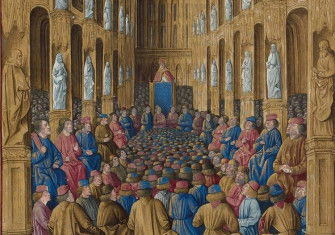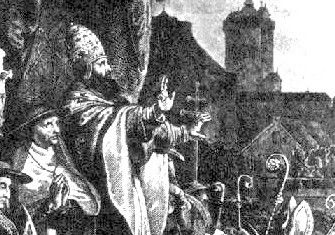Three perspectives on the Crusades
When did the fortunes of war turn against the crusader states? Three historians offer their views.
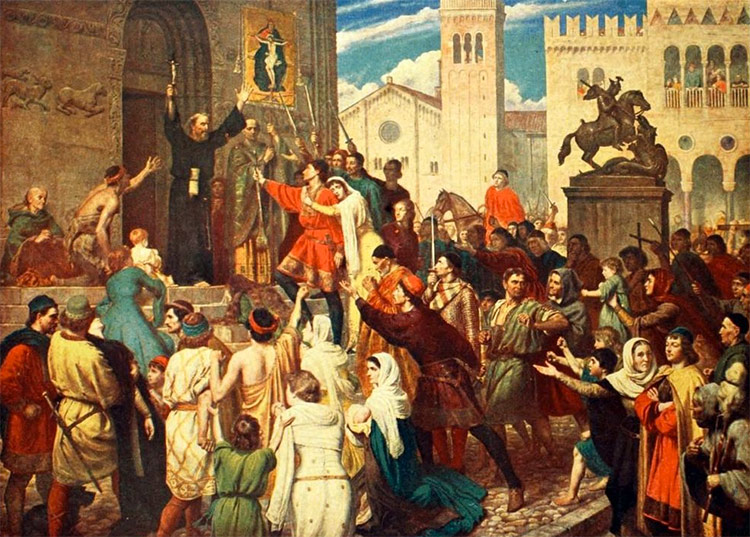 By 1187 the crusader kingdom of Jerusalem was in its 88th year. It had been founded by the first crusaders in 1099 and over the decades it had flourished into a powerful realm. Still, in this year, the kingdom’s army under King Guy of Lusignan suffered a catastrophic defeat at the hands of the Kurdish ruler Saladin. At a place called Hattin the army was all but annihilated, leaving Christian territory virtually defenceless. Within months the kingdom had all but collapsed, Jerusalem fell and all the kingdom’s remaining cities except Tyre were lost to the advancing Muslim forces. To the north the smaller crusader states were soon fighting for their very existence. Explaining these colossal reverses has been a major pre-occupation for historians over the centuries and one particularly contentious issue has been to explain when the kingdom first began to decline. When was the turning-point?
By 1187 the crusader kingdom of Jerusalem was in its 88th year. It had been founded by the first crusaders in 1099 and over the decades it had flourished into a powerful realm. Still, in this year, the kingdom’s army under King Guy of Lusignan suffered a catastrophic defeat at the hands of the Kurdish ruler Saladin. At a place called Hattin the army was all but annihilated, leaving Christian territory virtually defenceless. Within months the kingdom had all but collapsed, Jerusalem fell and all the kingdom’s remaining cities except Tyre were lost to the advancing Muslim forces. To the north the smaller crusader states were soon fighting for their very existence. Explaining these colossal reverses has been a major pre-occupation for historians over the centuries and one particularly contentious issue has been to explain when the kingdom first began to decline. When was the turning-point?
Some have suggested that in 1187 – on the very eve of its near-destruction – the kingdom was as strong as it ever had been. Others have argued that this reverse was simply the knock-out blow which collapsed a group of states that had long been in decline.
Three historians, all from Nottingham Trent university, identify the key turning point which they feel drove the crusader states into a spiral of decline that would culminate in Saladin’s great victory.
The Siege of Damascus (1148)
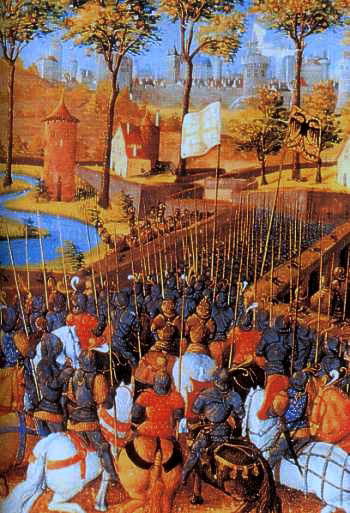
In 1148 the European leaders of the Second Crusade, Louis VII, king of France, his queen, Eleanor of Aquitaine and Conrad III of Germany arrived in the kingdom of Jerusalem. There they met with Queen Melisende and her 18-year-old son Baldwin, the joint leaders of the kingdom, which was the strongest of the crusader states. In this meeting they had a decision to make. They gathered a great parlement in which they could hear the arguments and counsel of the prelates and barons of the kingdom as well as the various bishops, dukes, margraves and counts who had travelled to the Holy Land. The decision they had to make concerned the military objective for the forces they had brought with them from Western Europe and those of the Latin East gathered at Jerusalem.
The Second Crusade was a response to the call by Pope Eugenius III for Western Europeans to embark on an armed expedition to take back the city of Edessa. That city had been captured by the First Crusaders in 1098 but was lost to the Muslim leader Zengi in 1144. As a result of the preaching of persuasive churchmen, such as Bernard of Clairvaux, the Second Crusade attracted enthusiastic support across Western Europe and resulted in large armies and fleets of ships converging on the Holy Land during 1147 and through 1148. The western armies had lost men and horses on disastrous journeys over the sea and across land, through Europe, the Balkans and the territory we now know as Turkey. Their forces had been split, they had suffered constant harassment and some serious defeats. Despite this, however, sufficient forces had reached the Holy Land from Western Europe to create the strongest Christian military force assembled there since the First Crusade. After much debate they decided that they would attack the city of Damascus.
In the half-century since the establishment of the kingdom of Jerusalem, its leaders had both fought and forged links with their neighbours. These links were usually based on the pragmatic needs of each party, to trade, to dispense justice and to live in peace. These practical requirements often led to relationships between Muslim and Christian rulers that were cooperative and mutually beneficial. They were sometimes forged out of the need to oppose a common enemy or to benefit from economic opportunities that could not be taken advantage of without cooperation. In 1099 the fall of Jerusalem to the First Crusaders had seen a massacre of the Muslim population of the city that one western chronicler called an ‘indescribable slaughter’. But, nearly two generations later, all of those responsible for the massacre were dead and the Christians of the east were no longer French, Flemish or Norman, but natives of Jerusalem, Tripoli and Antioch. They retained their Christian religion and much of their culture, but their fathers and grandfathers had usually married local Christian women and this new generation had been born and raised in the East.
As such they would have met with Muslims, made deals with them, exchanged gifts and emissaries and even arranged treaties. In other words, in the 50 years since the massacre at Jerusalem the relationships between Muslim and Christian in the Holy Land had changed from constant hostility and violence, not to one of peace and tranquillity, but to at least a more normal interaction of competition and local rivalry. A form of mutual respect had developed in which chroniclers such as Usama ibn Munqidh, writing in the 1180s, recalled the Templars he stayed with in Jerusalem in the 1140s as ‘my friends’ and lamented the disruptive arrival of new Westerners as ignorant men who were rough in character and unused to Muslim ways.
I am not arguing that Christians and Muslims in the Holy Land in the middle of the 12th century lived in peace and harmony, but that they had developed an understanding and carried on diplomatic, political and economic relations in much the same way as the Muslims had with other local Christian rivals like the Byzantines and the Armenians. This understanding developed to such an extent that, when in 1133 the great Muslim city of Damascus had been threatened by Zengi, the ruler of Mosul, the atabeg of Damascus, Muin al-Din Unur, turned to the ruler of the Christian kingdom of Jerusalem, Fulk, to provide support. Zengi had declared a Jihad against the Christians of the East, while at the same time attacking his fellow Muslims. When he died his son, Nur al-Din, took up the jihad with even greater fervour, denouncing the Damascenes for their alliance with the Jerusalemites. Despite this condemnation the alliance between Jerusalem and Damascus against their common enemy continued for several years thereafter.
In light of this I would argue that in 1148 there existed at least the possibility of normal relations between the Jerusalemites who had become, to use Munqidh’s word, ‘acclimatised’ to the east and their moderate Muslim neighbours. But the decision of the parlement in Jerusalem to take an army and lay siege to Damascus – a siege that failed miserably – meant that any policy of alliance and cooperation became completely discredited in Syria. It meant that the pragmatists who wanted to trade and live harmoniously and profitably with their neighbours were swept out of power and replaced by men who had sworn to push the Christians into the sea.
The Christian east had always been isolated and vulnerable to a united Muslim force and the ill-judged decision of 1148 to attack Damascus enabled the creation of that unity under a banner declaring jihad. Once faced with a united and antagonistic Muslim force the end of the Crusader States grew much more likely.
Steven Biddlecombe
Saladin's capture of Damascus (1174)
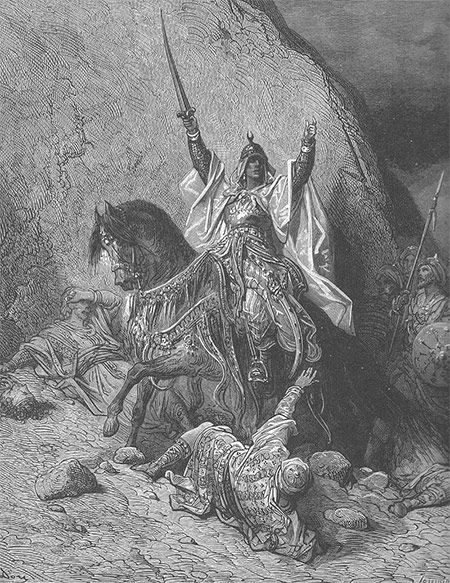
When Saladin’s army crossed the river Jordan and encamped on the high-ground above the city of Tiberias in 1187, it is thought to have numbered around 30,000 troops. This was a colossal force. Saladin's master Nur ad-Din – still less Nur ad-Din's father Zengi – had never mustered an army of this size. The simple fact that he could deploy on this scale was a towering achievement. It was also necessary. The kingdom of Jerusalem’s army represented the formidable war-machine of a first-rate power. Even though it had suffered a small defeat at Cresson a few months previously, King Guy of Jerusalem could still muster around 20,000 troops; a host larger than almost any other army raised by this Christian kingdom. In 1187 the kingdom's fundamental military might was as strong as it ever had been. There had been no real decline. True, there was vicious infighting among the Christian elites (and this needs to be taken seriously), but the kingdom's resources themselves were both strong and intact.
The disaster of Hattin is not a tale of one declining Christian kingdom being crushed by an ascendant Muslim power. It is rather the story of a still-strong Christian power being out-competed by an exceptionally dynamic Muslim ruler. The roots of the kingdom’s fall therefore need to be located on the Muslim side of the border; examining how Saladin was able to forge an army capable of achieving what his forebears had scarcely ever contemplated: the ability to risk battle against the kingdom of Jerusalem's main army. The roots of this rise will now be examined.
At risk of over-simplification, the Muslim territories neighbouring the crusader states fell into two blocks: Syria and Egypt. Before the 1160s these blocks had never been united, but they each had discernible strengths. The Turkish rulers of Syria had always been able to draw heavily upon large reserves of manpower. Recruits could be sourced relatively easily from the Turcoman tribes migrating across the region or from the Turkish territories further to the east in Iraq and Persia. It was also quite wealthy. Still its financial power was dwarfed by that of Egypt. Egypt’s fertile Nile Delta coupled with its trading ports of Alexandria and Damietta (crucial termini along the Silk Roads and African gold routes) commanded enormous revenues that made the Fatimid rulers of Egypt exceptionally powerful.
Saladin’s great achievement was – through war – to unite Egypt’s wealth with Syria’s manpower. The resultant mix gave him the resources to out-compete the Christian armies in open battle. Technically, he was not the first ruler to achieve this. Back in 1169, Saladin had been an officer in the army sent by his master Nur ad-Din from Syria to conquer Egypt. The army’s commander Shirkuh had succeeded in this goal and taken power in Cairo in his master’s name, but he died shortly afterwards and Saladin immediately then took power for himself. In the following years, Saladin refused to join forces with his master Nur ad-Din and the opportunity to strike a knock-out blow against the crusaders was lost. After Nur ad-Din's death, however, Saladin took the initiative; immediately striking into Syria, disinheriting Nur ad-Din's heirs and subjugating the entire region. By 1186, with the conquest of Aleppo, both Muslim Syria and Egypt in their entirety were in his hands.
The crucial moment in Saladin's conjunction of Egypt and Syria occurred in 1174. In this year Saladin left Egypt and crossed hundreds of miles desert and Christian-held territory to force his way into Damascus. This was a risky business. Saladin was far from Egypt and had no place of retreat. Still the gamble worked and with Damascus under his control, he had a firm foothold in Syria from which he could not easily be dislodged. From this moment onwards Saladin was able to yoke Egyptian wealth to the Turkish manpower of Syria and this potent mix gave him the ability to contemplate the overthrow of the crusader kingdom. Without this conjunction of wealth and manpower, such a goal would have been unthinkable.
Thus, 1174 is the crucial turning point in the fortunes of war; an event that actually did not involve the crusaders but which gave Saladin the resources that would fuel his rise to power and his eventual ability to out-compete and then crush the kingdom of Jerusalem’s army.
Nicholas Morton
The decision to march to Tiberias (July 3rd, 1187)
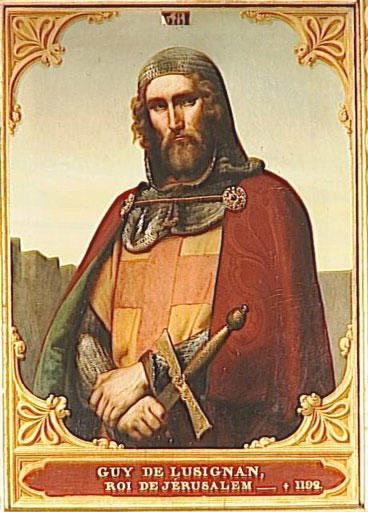
Just before the battle of Hattin, Guy of Lusignan, king of Jerusalem, and the top men of the realm faced a choice. Saladin had besieged and captured Tiberias, a stronghold of the powerful nobleman Raymond III of Tripoli, but his wife Eschiva was holding out in the citadel. Should they march to her rescue or hold firm at the strategically superior mustering point of Saforie? At Saforie they had a degree of protection and water, whereas the march to Tiberias would be fraught with danger and supplies would be limited until they could reach the lake. Guy had assembled c.1,200 knights, 4,000 light cavalry and 11,000-14,000 infantry in response to Saladin’s raiding of the Transjordan area in May 1187. It was the largest army that the kingdom of Jerusalem could muster, but significantly smaller than the forces commanded by Saladin. Why, then, did the Latin army decide to march into the jaws of a catastrophic defeat?
King Guy has often been blamed for listening to poor advice and for general incompetence leading up to Hattin, but his was not an easy position. He came to the throne through marriage to Sibylla, sister to the leper king, Baldwin IV, in 1180. He acted as regent for Baldwin during bouts of his illness. However, when faced with a similar incursion by Saladin in 1183, Guy chose to follow a containment policy and failed to respond to Muslim raids. He was subsequently accused of cowardice. Baldwin removed him from office in a rage and tried to annul his marriage to Sibylla. This experience may have influenced Guy’s decision in 1187 when he chose action over restraint. It certainly affected his standing in the kingdom. When the leper king died in 1185, Sibylla’s young son from a previous marriage inherited, but she and Guy were passed over for the regency in favour of Raymond III of Tripoli. Guy’s kingship was further complicated by a potential rival claimant to the throne: Sibylla’s younger half-sister Isabella. Attempts were made to separate Guy from Sibylla on the death of young Baldwin V, but his wife showed considerable mettle in keeping her husband. The pair were crowned in 1186. The important nobles Raymond III of Tripoli and Baldwin of Ibelin refused to pay Guy homage, but any immediate threat from Isabella was swiftly removed. On the eve of Hattin, Guy was arguably in the strongest position he had held thus far in his career, yet he still needed to prove his leadership. A victory over Saladin, especially in the territory of his rival Raymond III, might have sealed his reputation and secured his position.
As it turned out, the decision to march to Tiberias was the most significant turning point that the kingdom of Jerusalem ever faced. The army of the kingdom was outnumbered, harried by light cavalry and archers and slow-moving as the infantry walked to protect the heavy cavalry. The limited springs at Turan en route were unable to supply the army with the water it desperately needed, and enemy brush fires added smoke and confusion to the advance. By the time of the retreat to the Horns of Hattin, the Latin army had ground to a halt, but even Saladin was not convinced of his victory until King Guy’s tent fell. It was this triumph which sealed the fate of the Latin Kingdom. Guy’s levy had been so successful that few troops remained to garrison the important forts and castles which Saladin subsequently captured. Before the arrival of the Third Crusade, only Tyre remained in Latin hands.
Guy is unlikely to have set out to Tiberias if he thought that he was facing certain defeat. He may have been misinformed about the number of troops who opposed him and the availability of water, but he was an experienced campaigner who had been fighting in the Holy Land for many years. He could have employed a policy of containment as he had successfully in 1183, even though it cost his reputation. By marching, he may have hoped to emulate Baldwin IV, who despite his leprosy had achieved victory over Saladin’s numerically superior forces at Mont Gisard in 1177. But pitched battles were risky – their outcomes uncertain. Diplomacy might have worked more effectively. Saladin was an adept diplomat and was prepared to make treaties with Christians when it suited him, despite the legacy of 1148. He honoured an earlier truce organised by the regent Raymond III; he did not attack the Latin Kingdom until it ran out in April 1187. Saladin’s raiding tactics prior to Hattin, however, suggest that this time he was determined to provoke an encounter.
Saladin was unquestionably the more powerful ruler, but even after he gained Damascus in 1174 King Baldwin IV successfully held off a united Muslim force for nine years. On Saladin’s death in 1193, the unity he had forged between Syria and Egypt disintegrated. Under Guy’s rule the Latin Christians, who had always been outnumbered in the Levant, could have maintained a defensive strategy utilising their castles and forts, buying time to seek external support until the immediate threat had passed. The march to rescue Tiberias was the act of a dutiful king as well as an ambitious lord, but it was ultimately a gamble that played out at enormous cost to the kingdom.
Natasha Hodgson



